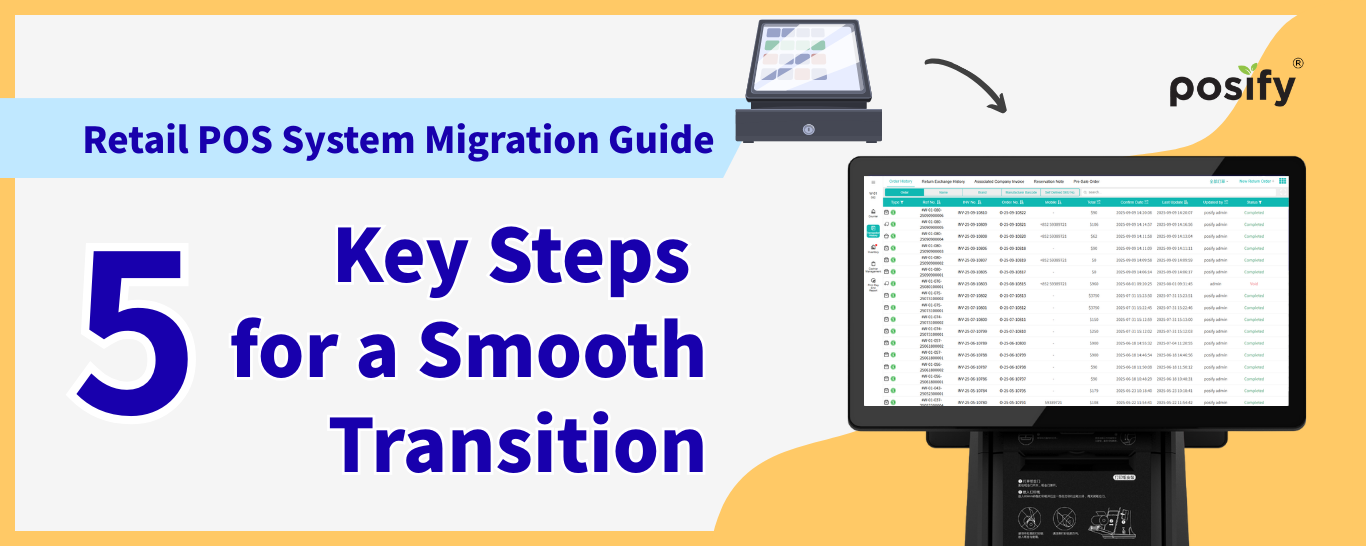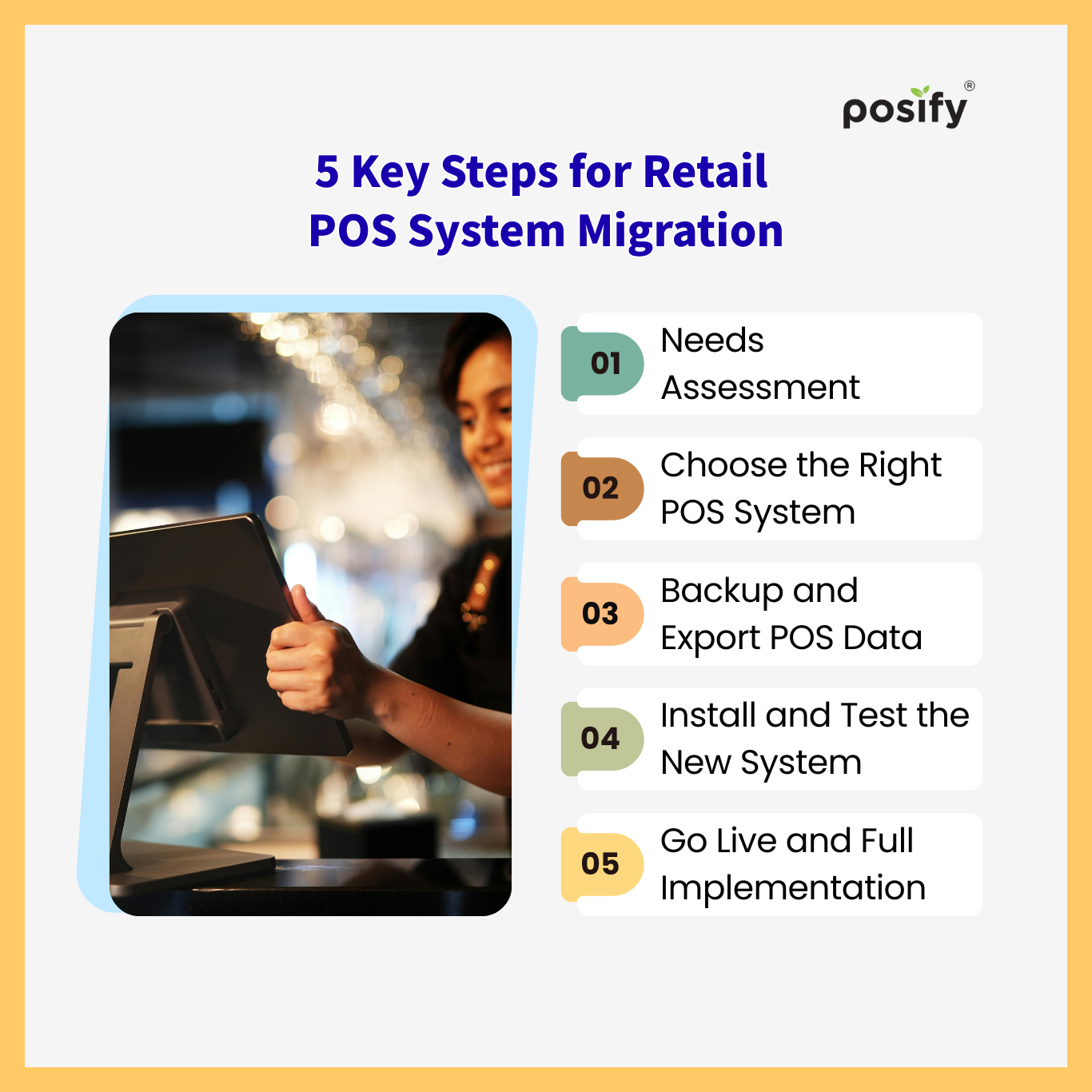The Complete Guide to Retail POS System Migration: 5 Key Steps for a Smooth Transition

As digitalization accelerates in the retail and F&B sectors, POS systems are no longer just “cash registers”—they have become core platforms integrating inventory, membership, marketing, and operational data. However, many businesses face a critical challenge during operations: POS system migration.
“POS migration” refers to switching from an existing POS system to a new platform. If mishandled, this process can disrupt daily operations, lead to lost customer data, inventory errors, or incomplete revenue reports. This article will walk you through the migration process, challenges, and best practices, helping you transition with confidence.
Why Migrate Your POS System?
As businesses grow and consumer habits evolve rapidly, legacy systems often struggle to keep up. Consider replacing your POS system if you encounter any of the following situations:
1. Insufficient Functionality for Diverse Operations
With digital transformation, simple checkout functionality is no longer enough. Older systems may lack:
-
Membership and CRM management: Modern customers value exclusive offers and rewards. Without the ability to track customer data and purchase history, targeted marketing becomes difficult.
-
Automated marketing tools: Birthday coupons, repurchase reminders, and points accumulation are crucial for customer retention.
-
Mobile payment support: Increasingly, consumers prefer electronic payments. Legacy systems that only support cash or limited card options may negatively affect customer experience.
Contact our professional consultants on WhatsApp now to learn more about Posify cloud POS system!
2. Maintenance Challenges Reducing Operational Efficiency
Many POS systems in use today are outdated versions installed years ago. Over time, issues may emerge:
-
Aging technology: Complex interfaces and cumbersome workflows increase training costs and reduce staff efficiency.
-
Frequent bugs: Checkout errors, invoice failures, and lost report data disrupt operations.
When your POS system becomes a “problem generator” rather than an operational aid, migration becomes necessary to avoid hidden daily costs.
3. Expansion Needs Outpace Legacy Systems
Older systems may suffice initially but struggle as your business grows:
-
Multi-store management challenges: If a POS supports only a single store, opening a second branch requires a separate system, scattering data and complicating reporting.
-
Cross-region operations: Real-time tracking of sales and inventory across cities or countries requires cloud-based synchronization, which older systems often lack.
-
E-commerce and online stores: Modern retail demands omnichannel integration. Without POS-ecommerce connectivity, online and offline data remain disconnected.
In short, legacy systems may meet current needs but can become a ceiling, slowing your brand’s growth.
5 Key Steps for Retail POS System Migration
For growing or upgrading retail businesses, POS migration is often unavoidable. To ensure a smooth transition and avoid operational downtime, here are five key steps for an efficient system migration:

Step 1: Needs Assessment
Before planning a POS migration, conduct a thorough review of your current system’s strengths and weaknesses. Identify operational gaps and bottlenecks:
-
Does the system remain stable during peak transactions?
-
Are commonly used payment methods supported?
-
Do you need enhanced multi-store management for new branches?
-
Are there delays or errors in reporting or inventory management?
-
Are there hidden costs, such as maintenance, upgrades, or additional module fees?
Consider both current needs and the next 2–3 years of growth to ensure the new system is flexible and scalable.
Step 2: Choose the Right POS System
Selecting a new POS system is the core of migration. Focus on system features, stability, and scalability:
-
System research and comparison: Collect information on multiple POS solutions. Focus on stability, cloud vs. local deployment, user-friendliness, technical support, and pricing. Also, consider peer reviews to understand advantages, drawbacks, and potential issues.
-
Testing and trial: If a trial or demo is available, simulate daily operations to test transaction speed, report generation, inventory updates, and integration with external systems. Pay special attention to payment, membership, and promotion functionalities.
Step 3: Backup and Export POS Data
List all data that needs migration, including:
-
Membership and customer data: Levels, points, purchase history.
-
Inventory data: Stock quantities, batch/serial numbers, restock records.
-
Product data: Names, barcodes, prices, categories.
-
Transaction history: Past sales, invoices, returns/exchanges.
-
Reports: Store revenue, best-selling items, inventory audits.
-
Employee and operational data: Login records, shift schedules, sales figures.
-
Supplier and restock info: Vendors, delivery dates, purchase costs.
Ensure all data is fully backed up and verified. Use this opportunity to clean expired products or duplicate accounts.
Step 4: Install and Test the New System
Before going live, install and thoroughly test the new system:
-
Simulate daily transactions, returns, discounts, and inventory synchronization to confirm full operational support.
-
Identify potential issues early and adjust with vendor support.
This stage is crucial to prevent operational disruptions during the official launch.
Step 5: Go Live and Full Implementation
After switching to the new POS, adopt a staged rollout rather than a full-scale switch:
-
Start with select stores or low-risk periods and monitor system performance.
-
Track operational metrics such as transaction success rate, inventory synchronization, and customer payment experience.
-
Maintain close communication with the vendor for immediate support if issues arise, minimizing risks.
Conclusion
POS system migration requires meticulous planning. Every step—from needs assessment, system selection, data migration, to testing—affects operational success. With a clear process and a reliable POS vendor, risks can be minimized, enabling your business to enjoy higher efficiency and comprehensive digital operations.
If you’re planning a POS upgrade or migration, Posify is your trusted partner: from professional consultation, full data import, and system training, to ongoing maintenance support, we provide a one-stop solution so you can focus on growing your business.
👉 Contact Posify now to start your journey toward smart retail operations!






